
SOUP Cordially Invites you to The President’s Ball, Saturday, April 9th in Somerset, 3rd Floor of Warch, 8:00 pm – midnight. Formal Attire. Live Music, Dancing, 360 Photo booth, Cake and a Mocktail Bar. Step into the Forest….


SOUP Cordially Invites you to The President’s Ball, Saturday, April 9th in Somerset, 3rd Floor of Warch, 8:00 pm – midnight. Formal Attire. Live Music, Dancing, 360 Photo booth, Cake and a Mocktail Bar. Step into the Forest….
Manual materials handling (MMH) means moving or handling things by lifting, lowering, pushing, pulling, carrying, holding or restraining. Manual materials handling is also the most common cause of occupational fatigue, low back pain and lower back injuries.

What makes manual materials handling hazardous?
MMH is always hazardous but the level of hazard depends on what you are handling, what the task is, and what the conditions are at the workplace or work site.
For example, the material or load that you are handling may be:
The task can make MMH hazardous if a worker:
The conditions where you are working can also contribute to hazards of MMH and result in injuries, for example:
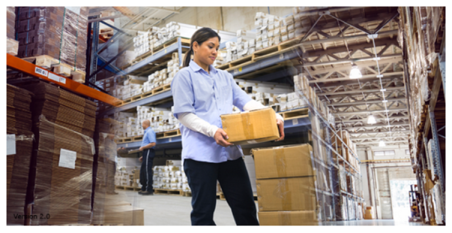
For more detailed information on a particular manual materials handling (MMH) topic, click on the document title below:
To prevent or reduce stiffness and pain from sitting all day, try simple desk stretches.
The problem: Prolonged sitting
If you work at a desk or computer for long stretches of time, you might place excessive stress on certain muscles. As a result, you’re likely to get stiff and sore — unless you take frequent breaks for physical activity.
The solution: Fitness breaks
Breaking up your workday with stretches and other physical activities can help keep you comfortable while you work. You can stretch while you’re seated at your desk or standing in your workspace. You might even be able to stretch while you’re participating in a conference call or other workplace activities. You don’t need special equipment to stretch, and you won’t break a sweat — yet the results can be powerful.
Try a few of the stretches below, which can be done right from the comfort of your work area (watch the videos by Mayo Clinic Staff to understand proper form and technique):
“Just a small amount of movement throughout the day can really help you stay alert and focused.” Beau Johnson is a physical therapist in Holmen, Wisconsin.
Want more stretching examples? Check this out.
15 Simple and Quick Office Stretches to Boost Work Efficiency
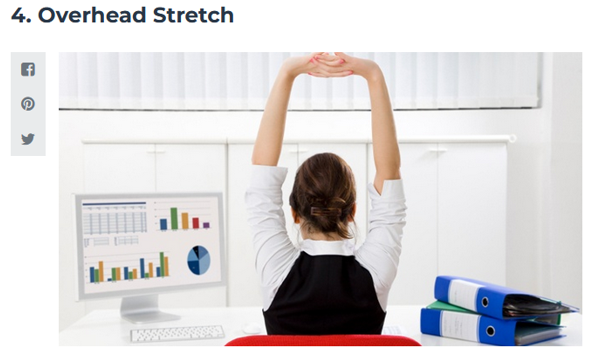
Example number 4, is a natural stretch that we all do when we’re feeling a bit stiff and tired. Simply raise your arms above your head, interlock your fingers and push away from yourself.
Sources: https://www.mayoclinic.org/healthy-lifestyle/adult-health/in-depth/office-stretches/art-20046041; https://www.lifehack.org/articles/productivity/15-simple-and-quick-office-stretches-boost-work-efficiency.html

Until March 24th
Help us stock the Student Food Pantry for our Lawrentians!
What We Need:
Drop off donations in the D&IC kitchen in Memorial Hall or email jessica.quintana@lawrence.edu

Always choose the cleaner, sanitizer or disinfectant product with the least hazardous ingredients that will accomplish the task at hand. Read the label to understand how to properly use the product, and follow any safety and precautionary statements provided on the label.
Workplaces use cleaning chemicals to ensure the cleanliness of their buildings. Workers who handle these products include building maintenance workers, janitors and housekeepers. Some cleaning chemicals can be hazardous, causing problems ranging from skin rashes and burns to coughing and asthma.
The Environmental Protection Agency (EPA) defines cleaners, sanitizers and disinfectants as follows:
Cleaners remove dirt through wiping, scrubbing or mopping.
Sanitizers contain chemicals that reduce, but do not necessarily eliminate, microorganisms such as bacteria, viruses and molds from surfaces. Public health codes may require cleaning with the use of sanitizers in certain areas, like toilets and food preparation areas.
Disinfectants contain chemicals that destroy or inactivate microorganisms that cause infections. Disinfectants are critical for infection control in hospitals and other healthcare settings.
Cleaners, sanitizers and disinfectants serve different purposes, and it is important to choose the least hazardous cleaning chemical that will accomplish the task at hand. Before purchasing cleaning products, determine whether or not sanitizing or disinfecting is necessary. If sanitizing or disinfecting is not required, then choose a cleaner. In general, disinfectants and sanitizers are more hazardous than cleaners.
If sanitizing or disinfecting is necessary, be sure that the product purchased is effective for the microorganisms being targeted. EPA regulates sanitizers and disinfectants (termed “antimicrobial pesticides”). For further information, see EPA’s webpage “What Are Antimicrobial Pesticides?” (www.epa.gov/pesticide-registration/what-are-antimicrobial-pesticides ).
Potential Health Problems Caused by Cleaning Chemicals
Many factors influence whether a cleaning chemical will cause health problems. Some important factors to consider include:
Chemicals in some cleaning products can be irritating to the skin or can cause rashes. Cleaning products that contain corrosive chemicals can cause severe burns if splashed on the skin or in the eyes (e.g.; drain cleaners, toilet bowl cleaners, acid-based cleaners).
Mists, vapors and/or gases from cleaning chemicals can irritate the eyes, nose, throat and lungs. Symptoms may include burning eyes, sore throat, coughing, trouble breathing and wheezing. Mixing cleaning products that contain bleach and ammonia can cause severe lung damage or death.
Safe Work Practices When Using Cleaning Chemicals
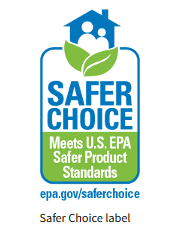
Criteria for Safer Chemical Ingredients – https://www.epa.gov/saferchoice.
Each chemical ingredient in a formulation has a function in making a product work – whether it is to aid in cleaning by reducing surface tension (surfactants), dissolve or suspend materials (solvents), or reduce water hardness (chelating agents). The Safer Choice Program evaluates each ingredient in a formulation against the following Master and Functional-Class Criteria documents, as appropriate. These documents define the characteristics and toxicity thresholds for ingredients that are acceptable in Safer Choice products.
Sources: OSHA/NIOSH INFOSHEET: Protecting Workers Who Use Cleaning Chemicals; Safer Choice Standard and Criteria, https://www.epa.gov/safechoice/standard.
One last faculty lunch for the Winter 2022 term! Join colleagues for a BYO lunch in the Viking Room on Friday, March 4 (week 9) from 12:30 to 1:30 pm.
No alcohol will be served, but there will be a complimentary coffee and tea cart for your mid-day caffeine fix. Stop by to grab a cup even if you can’t stay for lunch – seriously, come get a hot beverage!
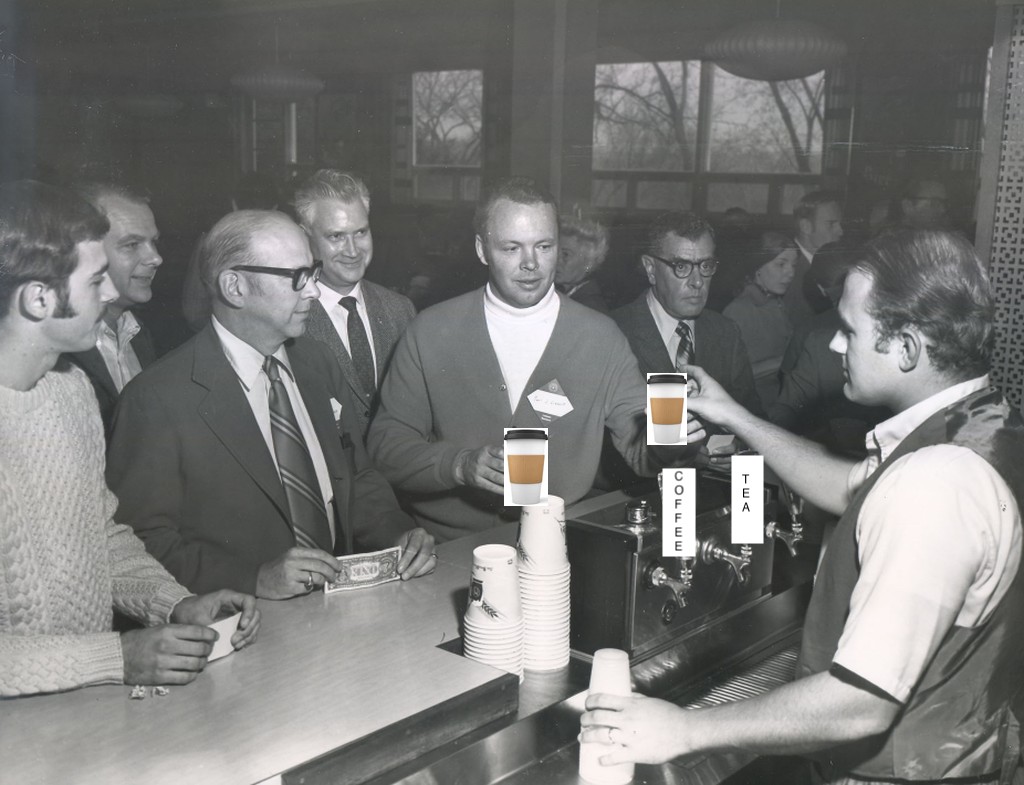
Winter Term Closing for all Lawrentians will take place in the Somerset Room on Friday, March 11th at 4:30 pm. and will close with a community walk to the Goldgarden to release our regrets, gratitude, and prayers for the term.
Spiritual and Religious Life invites you to take time to acknowledge a turning and the impact that this term has had on our community, our relationships, our knowledge, our dreams, and our souls. When we pause to see from multiple perspectives then it is possible to hold hard and joyful, growth and struggle, loneliness and community in the same space. We hope you will plan to resist isolation and be part of a shared experience.
The environment of your work site is the first factor in choosing the material from which your ladder is constructed. Ladders are built from one of three basic materials: wood, fiberglass and metal (aluminum). For example, if you are working near sources of electricity, a metal ladder should be rejected since aluminum is an electrical conductor.
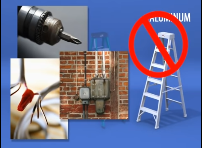
Your body can complete an electrical circuit between the electrical power source, the ladder, and then to the ground in the event of a live wire contact incident. An electrical shock while working from a ladder can trigger a fall or cause your heart to stop leading to serious injury or death. On the other hand, if there are no electrical power sources in your work area, the aluminum ladder is the lightest weight when compared to fiberglass or wood.
After checking the environment of the work site, and where the ladder will be setup, the proper ladder length must be selected. It is unsafe to use a ladder that is too long or too short. When using a Step Ladder, for example, standing on the top cap or the step below the top cap is not permitted due to the increased likelihood of losing your balance. Likewise, when using an Extension Ladder, the top three rungs are not to be used for climbing. Safety standards require a label on the ladder to indicate the highest standing level.
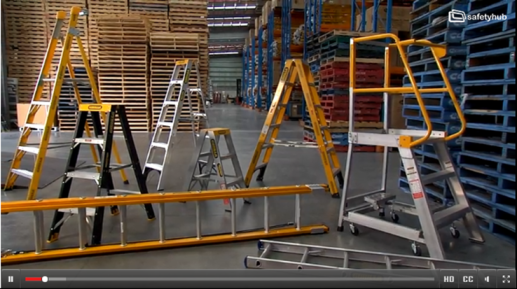
Next, consider the Duty Rating of the ladder. This is an indication of the maximum weight capacity the ladder can safely carry. To figure out the total amount of weight your ladder will be supporting, add your weight plus all tools, supplies, and other objects placed upon the ladder.
There are five categories of ladder Duty Ratings:
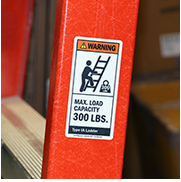
Basic Ladder Safety
Ladders are tools. Many of the basic safety rules that apply to most tools also apply to the safe use of a ladder:
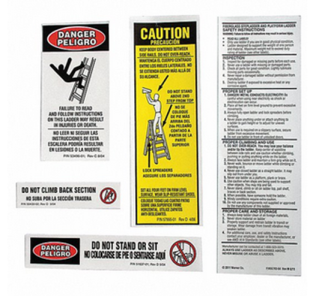
At all times utilize Three Points-of-Contact
When climbing a ladder, it is safest to utilize Three Points-of-Contact because it minimizes the chances of slipping and falling from the ladder. At all times during ascent, descent, and working, the climber must face the ladder and have two hands and one foot, or two feet and one hand in contact with the ladder steps, rungs and/or side rails.
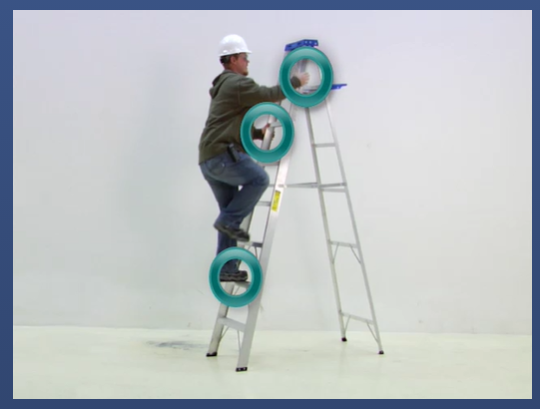
Although the user’s weight or size typically does not increase the likelihood of a fall, improper climbing posture creates user clumsiness and may cause falls. Reduce your chances of falling during the climb by:
Factors contributing to falls from ladders include haste, sudden movement, lack of attention, the condition of the ladder (worn or damaged), the user’s age or physical condition, or both, and the user’s footwear.
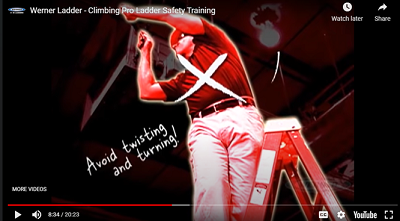
Follow these basic and important safety rules when using a ladder to reduce your chances of falling while using a ladder at work or at home.
Source: https://www.americanladderinstitute.org/page/Ladders101
Tasks requiring prolonged use of Display Screen Equipment (DSE) can present real hazards to users. Use of DSE equipment requires proper management to control the hazards and reduce the risks to display screen equipment users.
Equipment categorized as display screen equipment include: desktop and laptop computers, tablets, smartphones, LCD monitors, and all varieties of touchscreens (alphanumeric or graphic) .
The three main hazards of prolonged use of display screen equipment are musculoskeletal injuries, visual fatigue and stress.
Musculoskeletal Injury (MSI)
An injury or disorder of the soft tissues, including tendons, ligaments, blood vessels and nerves, arising from exposure to risk factors such as:
Signs and Symptoms of Musculoskeletal Injuries
These can include tenderness, weakness, tingling, disturbed sleep, swelling, numbness, pain, unreasonable fatigue, and difficulty performing tasks or moving specific parts of the body. These injuries can be acute or cumulative. They result from one or more of these tissues having to work harder than they’re designed to.
Stages of Musculoskeletal Injuries
Early stage: Aching and tiredness of the affected limb occur during the work shift but disappear at night and during days off work. No reduction of work performance.
Intermediate stage: Aching and tiredness occur early in the work shift and persist at night. May also have reduced capacity for repetitive work.
Late stage: Aching, fatigue and weakness persist at rest. Inability to sleep and to perform light duties. Not everyone goes through these stages in the same way. In fact, it may be difficult to say exactly when one stage ends and the next begins. The first pain is a signal that the muscles and tendons should rest and recover. As soon as people recognize that they have a symptom, they should immediately do something about it.
Visual Fatigue: This occurs when a task involves looking at a screen for prolonged periods of time. Eyestrain and headaches can result from visual fatigue.
Stress: Psycho-social factors (e.g. high job demands, time pressures and lack of control) can cause muscle tension and headaches.
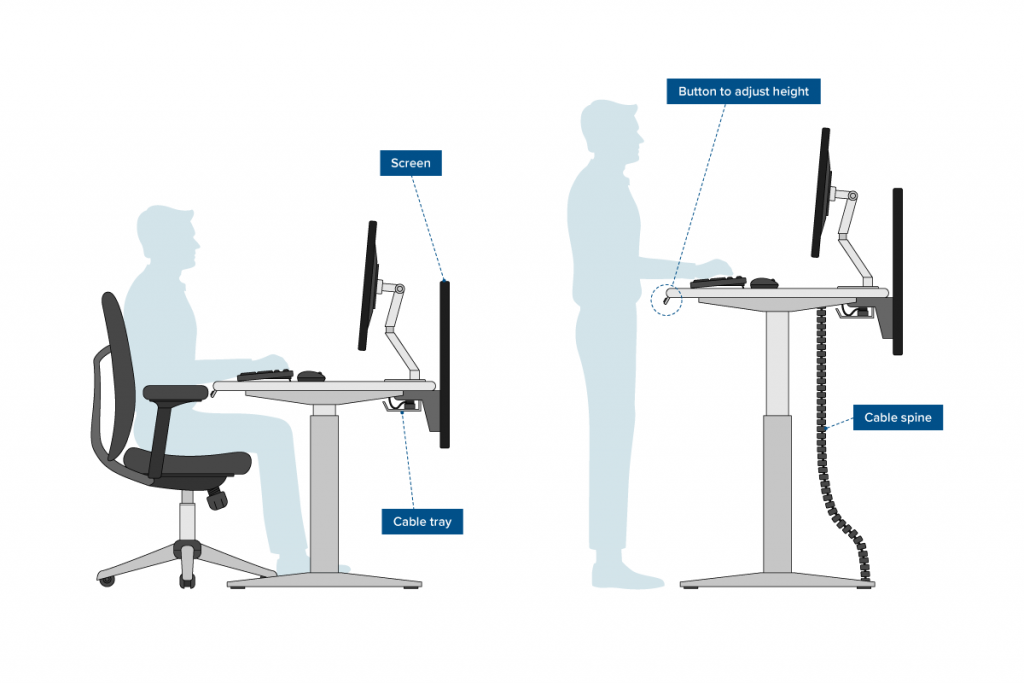
This image depicts optimal sitting and standing posture. Please note, however, that no posture is ideal indefinitely. You must change your posture and position frequently by alternating tasks (typing, writing, walking and standing) as often as possible. This will ensure proper blood flow and reduce the risk of injury.
The individual’s own posture at the workstation plays a major role in preventing injury.
Variety is a key issue in addressing Display Screen Equipment issues: in some cases, repetitive or monotonous job tasks may be rotated, so that individuals are not required to do the same thing exclusively for prolonged periods.
Breaks are crucial in ensuring good health and safety in all work situations. To prevent the pain and discomfort of staying in one place for long periods, it’s useful to step away, get a drink or just go for a walk to stretch the legs, and at the same time give your eyes a rest from the screen.
Exercise is another way to break up the day, stretching (activities and positions used to increase range of motion), changing position, and looking away from your screen occasionally.
Musculoskeletal problems, visual fatigue and stress all increase the longer a person stays in one place doing the same thing, so breaking up the working day is a major part of maintaining health.
An assessment of the workstation design, environmental factors, task or job design can be performed to minimize the risk and possibility of injury to users. Check out the display screen equipment workstation checklist at https://www.hse.gov.uk/pubns/ck1.pdf
Sources: IOSH – https://iosh.com/resources-and-research/our-resources/occupational-health-toolkit/musculoskeletal-disorders/preventative-action/ ; Safetyhub – Display Screen Equipment